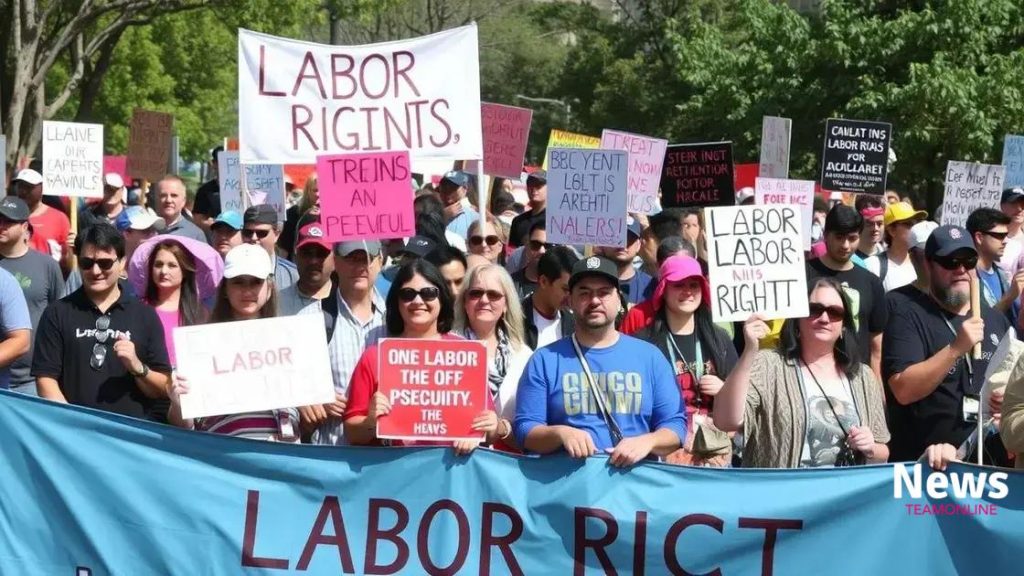Movement solidarity days legislation: what you need to know

Movement solidarity days legislation supports the collective action of workers and communities, leading to improved rights, enhanced awareness, and significant changes in labor laws and social justice initiatives.
Movement solidarity days legislation plays a crucial role in empowering workers and fostering community connections. Ever thought about how these laws shape our rights? Let’s explore their impact.
Understanding movement solidarity days
Understanding movement solidarity days is vital for anyone interested in community support and labor rights. These days exist to promote awareness and foster unity among individuals facing similar challenges in the workplace and society. When we recognize these events, we strengthen connections and rally support for important causes.
What Are Movement Solidarity Days?
Movement solidarity days represent designated times when communities come together to advocate for workers’ rights and social justice. They serve as a platform for raising awareness about critical issues while showcasing collective strength.
- Historical significance: These days often commemorate past struggles and victories.
- Activism focus: They highlight ongoing issues requiring immediate attention.
- Community engagement: They encourage individuals to participate and voice their support.
Throughout history, these solidarity days have been pivotal in uniting people from various backgrounds. They remind us of our shared goals and the importance of standing together. Events can feature rallies, educational workshops, and discussions on pressing topics. The diversity of activities allows for different forms of participation, catering to individual preferences and strengths.
Why Are Movement Solidarity Days Important?
Recognizing the significance of these days fosters a greater understanding of their impact. They not only raise awareness but also empower individuals to take action. By participating, people can:
- Learn about labor rights and community issues.
- Support local and global movements.
- Network with like-minded individuals.
Moreover, when people gather for a common cause, their voices become louder and more influential. This collective action has been known to lead to significant changes in legislation and workplace policies, reinforcing the notion that together, change is possible.
Ultimately, understanding movement solidarity days offers insights into the struggles that many face and the importance of unity in advocating for justice. By actively engaging in these events, individuals contribute to a stronger, more supportive community.
Key benefits of movement solidarity days legislation
The key benefits of movement solidarity days legislation are significant for both workers and communities. These laws create a framework for solidarity, ensuring that individuals stand together during challenging times. By recognizing these days, society can foster a greater sense of unity and support.
Empowerment of Workers
One major benefit is the empowerment of workers. When solidarity days are recognized legally, they provide a platform for workers to express their concerns and advocate for their rights. This recognition encourages individuals to unite and demand fair treatment, which can lead to significant changes in workplace conditions.
- Heightened awareness of labor issues.
- Increased participation in advocacy efforts.
- Greater visibility for marginalized voices.
Workers who participate in solidarity days often feel a sense of community that can help them overcome isolation. This collective sentiment boosts morale and encourages continued activism, contributing to long-term changes in policies and practices.
Strengthening Community Bonds
Another benefit of these legislations is the enhancement of community bonds. When communities come together for solidarity days, it fosters relationships among diverse groups. These connections are essential for building a supportive network that addresses local issues.
- Encourages collaboration between organizations.
- Facilitates sharing of resources and knowledge.
- Increases community resilience in facing challenges.
As communities unite for shared objectives, they cultivate a sense of belonging. This sense of unity can lead to greater civic engagement, as individuals feel more motivated to contribute to their communities.
Ultimately, movement solidarity days legislation not only supports workers but also enriches community ties. By recognizing these events, society can create an environment conducive to growth, understanding, and collective action.
How legislation impacts workers and communities

Understanding how legislation impacts workers and communities is crucial in today’s world. These laws establish frameworks that govern workplace rights, safety, and community well-being. When effective legislation is in place, it leads to improved conditions for everyone.
Enhancing Worker Rights
One of the primary impacts of legislation is the enhancement of worker rights. Laws create standards that employers must follow, protecting workers from exploitation. This includes regulations on wages, overtime, and workplace safety.
- Ensures fair pay for all workers.
- Establishes safe working conditions.
- Provides avenues for reporting grievances.
When workers know their rights, they are more likely to advocate for themselves and their peers. This sense of empowerment can lead to a more engaged and motivated workforce, which benefits employers as well.
Building Stronger Communities
Effective legislation also plays a significant role in building stronger communities. When workers are treated well, they contribute positively to their local areas. Healthy workplaces lead to:
- Increased economic stability within communities.
- Higher levels of community involvement.
- Greater support for local services and businesses.
Moreover, when legislation supports community programs and initiatives, it fosters a sense of belonging. Residents feel motivated to become involved, which enhances the overall community fabric.
Legislation can also address critical social issues, like discrimination and inequality, which further strengthens community ties. By promoting inclusiveness and fairness, laws can transform society for the better.
Ultimately, understanding the impact of legislation on workers and communities underscores the importance of advocating for fair policies. Positive changes in legislation benefit not only individuals but also the communities in which they live and work.
Examples of successful solidarity movements
Examples of successful solidarity movements highlight the power of collective action. These movements have demonstrated how individuals can come together to challenge injustices and advocate for their rights. From local initiatives to global campaigns, these examples inspire further action and solidarity.
The Civil Rights Movement
One of the most notable examples is the Civil Rights Movement in the United States. This movement sought to end racial segregation and discrimination against African Americans. Key figures like Martin Luther King Jr. organized peaceful protests and marches, bringing national attention to the struggle for equality.
- Montgomery Bus Boycott: A pivotal event where African Americans refused to ride segregated buses.
- March on Washington: A massive rally where Dr. King delivered his iconic “I Have a Dream” speech.
- Voting Rights Act: Legislation that aimed to eliminate barriers to voting for African Americans.
The success of this movement has had a lasting impact on legislation and civil rights, proving how solidarity can lead to profound change.
Labor Movement
Another example is the Labor Movement, which has played a crucial role in improving workers’ rights across various industries. Labor unions have organized strikes and collective bargaining efforts to secure fair wages and better working conditions.
- 1981 PATCO Strike: Air traffic controllers demanded better working conditions and wages, which brought national attention to labor issues.
- Fight for $15: A campaign advocating for a $15 minimum wage, uniting fast-food workers across the nation.
- Unionization efforts: Many industries, from teachers to factory workers, have banded together to push for rights and protections.
The Labor Movement showcases the impact that organized workers can have when they unite for common goals.
These examples of successful solidarity movements underline the importance of community, support, and collective action. By learning from these experiences, current and future movements can grow stronger and more effective in advocating for change.
Future outlook for movement solidarity legislation
The future outlook for movement solidarity legislation appears promising as more people recognize the importance of collective action. As society evolves, there is a growing awareness of the need for laws that support workers and communities. Movements advocating for change are becoming more organized and vocal, leading to a potential shift in legislative priorities.
Increasing Awareness and Advocacy
As globalization connects people, the fight for social justice is stronger than ever. Advocacy groups are utilizing social media and technology to amplify their messages. This increased visibility helps educate the public and garners support for important causes.
- Online campaigns: Activists are leveraging digital tools to reach broader audiences.
- Grassroots movements: Local organizations are mobilizing communities to push for change.
- Partnerships: Collaborations between various groups are enhancing advocacy efforts.
With more people engaged, there is greater potential for changes in solidarity legislation that reflect the needs of workers and communities.
Legislative Trends and Developments
Many countries are recognizing the need for stronger protections for workers. Recent trends indicate a push towards improved labor laws and policies that promote fairness and equality. Lawmakers are beginning to address issues such as wage gaps and workplace safety, reflecting the voices of those they represent.
- Raising minimum wage: More states and cities are implementing higher wage standards.
- Protecting gig economy workers: New regulations are helping freelance and gig workers gain rights and benefits.
- Expanding paid leave policies: Legislation is increasingly recognizing the importance of work-life balance.
As these trends continue, the landscape of movement solidarity legislation will evolve, potentially leading to more robust protections for workers.
In conclusion, the outlook for movement solidarity legislation is bright. As awareness grows and advocacy rises, there is hope for meaningful changes in laws that support workers and strengthen communities.
FAQ – Frequently Asked Questions about Movement Solidarity Legislation
What is movement solidarity legislation?
Movement solidarity legislation refers to laws that support workers and communities coming together to advocate for their rights and address inequalities.
How can solidarity movements impact legislative changes?
Solidarity movements create public awareness and advocacy, which can influence lawmakers to adopt more inclusive and equitable labor laws.
Why is community engagement important in solidarity days?
Community engagement fosters a sense of belonging and support, empowering individuals to participate actively in advocating for their rights.
What are some successful examples of solidarity movements?
Successful examples include the Civil Rights Movement and the Labor Movement, both of which led to significant changes in legislation that benefit workers and communities.





